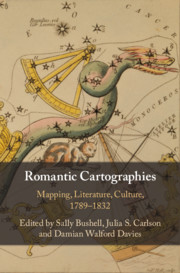Book contents
- Romantic Cartographies
- Romantic Cartographies
- Copyright page
- Contents
- Illustrations
- Notes on Contributors
- Preface
- Acknowledgements
- Introduction Romantic Cartographies
- Part I Romantic Maps, Romantic Mapping
- Part II Cartographic Encounters
- Chapter 5 Producing and Protesting Imperial Mapmindedness
- Chapter 6 Romantic Board Games and the ‘World in Play’
- Chapter 7 Carto-tactual Subjects
- Chapter 8 Wordsworth and Mandelbrot on the Coast of Britain
- Part III Beyond Romantic Cartographies
- Bibliography
- Index
Chapter 6 - Romantic Board Games and the ‘World in Play’
from Part II - Cartographic Encounters
Published online by Cambridge University Press: 15 January 2021
- Romantic Cartographies
- Romantic Cartographies
- Copyright page
- Contents
- Illustrations
- Notes on Contributors
- Preface
- Acknowledgements
- Introduction Romantic Cartographies
- Part I Romantic Maps, Romantic Mapping
- Part II Cartographic Encounters
- Chapter 5 Producing and Protesting Imperial Mapmindedness
- Chapter 6 Romantic Board Games and the ‘World in Play’
- Chapter 7 Carto-tactual Subjects
- Chapter 8 Wordsworth and Mandelbrot on the Coast of Britain
- Part III Beyond Romantic Cartographies
- Bibliography
- Index
Summary
During the eighteenth century, British publishers capitalized on a growing market for educational toys with board games aimed at teaching geography. These games used maps as game boards, encouraging children to view maps as sites of play. Yet the fixed version of the world presented in a gameboard map was often at odds both with the political realities of the period and with the rapid overturns of chance-driven gameplay. This essay analyses a series of surviving games from the period, illustrating the evolution of the geographical game from an eighteenth-century tool of nationalist propaganda to a more subversive nineteenth-century form that took advantage of board games’ inherent association with chance. In the board game, publishers found a visual form that could unite cartography with unpredictability and that could train players to read maps as stable representations of an unstable world. The mechanism of the game itself – its relationship to chance and unpredictability – ultimately came to be seen as a useful device for structuring the Romantics’ relationship to a world in flux.
- Type
- Chapter
- Information
- Romantic CartographiesMapping, Literature, Culture, 1789–1832, pp. 151 - 170Publisher: Cambridge University PressPrint publication year: 2020

